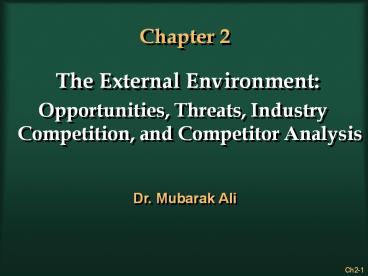The External Environment: - PowerPoint PPT Presentation
1 / 30
Title: The External Environment:
1
Chapter 2
- The External Environment
- Opportunities, Threats, Industry Competition, and
Competitor Analysis
Dr. Mubarak Ali
2
The Strategic Management Process
3
Components of the General Environment
4
Components of the General Environment
5
External Environmental Analysis
The external environmental analysis process
should be conducted on a continuous basis. This
process includes four activities
6
External Environmental Analysis
Top 10 U.S. States MovingToward Digital Economy
States in the top 10 of those that are trying to
transform themselves to the realities and needs
of a digital economy may experience an influx of
high-tech companies and skilled workers as well
as increases in tax revenues
7
Porters Five Forces Model of Competition
8
Threat of New Entrants
Expected Retaliation
9
Porters Five Forces Model of Competition
Threat of New Entrants
Threat of New Entrants
10
Bargaining Power of Suppliers
Suppliers are likely to be powerful if
11
Porters Five Forces Model of Competition
Threat of New Entrants
Threat of New Entrants
Bargaining Power of Suppliers
12
Bargaining Power of Buyers
Buyer groups are likely to be powerful if
13
Porters Five Forces Model of Competition
Threat of New Entrants
Threat of New Entrants
Bargaining Power of Buyers
Bargaining Power of Suppliers
14
Threat of Substitute Products
Keys to evaluate substitute products
15
Porters Five Forces Model of Competition
Threat of New Entrants
Threat of New Entrants
Bargaining Power of Buyers
Bargaining Power of Suppliers
Threat of Substitute Products
16
Rivalry Among Existing Competitors
17
Rivalry Among Existing Competitors
Cutthroat competition is more likely to occur
when
18
Rivalry Among Existing Competitors
High exit barriers are economic, strategic and
emotional factors which cause companies to remain
in an industry even when future profitability is
questionable.
19
Effects of Entry Barriers and Exit Barriers on
Industry Profits
Exit Barriers
High
Low
Low
Entry Barriers
High
20
Effects of Entry Barriers and Exit Barriers on
Industry Profits
Exit Barriers
High
Low
Low, Stable Returns
Low
Entry Barriers
High
21
Effects of Entry Barriers and Exit Barriers on
Industry Profits
Exit Barriers
High
Low
Low, Stable Returns
Low
Entry Barriers
High, Stable Returns
High
22
Effects of Entry Barriers and Exit Barriers on
Industry Profits
Exit Barriers
High
Low
Low, Risky Returns
Low, Stable Returns
Low
Entry Barriers
High, Stable Returns
High
23
Effects of Entry Barriers and Exit Barriers on
Industry Profits
Exit Barriers
High
Low
Low, Stable Returns
Low, Risky Returns
Low
Entry Barriers
High, Risky Returns
High, Stable Returns
High
24
Competitor Analysis
The follow-up to Industry Analysis is effective
analysis of a firms Competitors
25
Competitor Analysis
26
Competitor Analysis
Future Objectives
What Drives the competitor?
How do our goals compare to our competitors
goals?
Where will emphasis be placed in the future?
What is the attitude toward risk?
27
Competitor Analysis
Future Objectives
What is the competitor doing?
How do our goals compare to our competitors
goals?
What can the competitor do?
Current Strategy
Where will emphasis be placed in the future?
How are we currently competing?
What is the attitude toward risk?
Does this strategy support changes in the
competitive structure?
28
Competitor Analysis
What does the competitor believe about itself and
the industry?
Assumptions
Do we assume the future will be volatile?
What assumptions do our competitors hold about
the industry and themselves?
Are we assuming stable competitive conditions?
29
Competitor Analysis
What are the competitors capabilities?
Capabilities
What are my competitors strengths and weaknesses?
How do our capabilities compare to our
competitors?
30
Competitor Analysis
Response
What will our competitors do in the future?
Where do we have a competitive advantage?
How will this change our relationship with our
competition?































